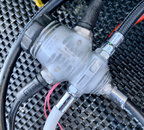In my experience of diving in cold water and ice diving second stages iced up and gave problems than first stages. I asked many divers if they had ice form over their first stage. The only ones that said yes were the three that went to Antarctica. In my view the second stage is just as important as the first stage when I comes to cold water. I’ve not seen any first stages with ice, but I’ve seen several second stages with ice in them.
I agree with tbone that many freeze ups are a result of operator era. Maintaining a good breathing pattern is important. Handling of the second stage (i.e. keep it out of the snow, don’t inhale with the reg in your mouth while on the surface) is also important.
I agree with tbone that many freeze ups are a result of operator era. Maintaining a good breathing pattern is important. Handling of the second stage (i.e. keep it out of the snow, don’t inhale with the reg in your mouth while on the surface) is also important.






